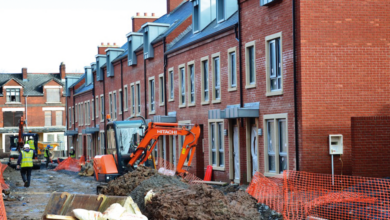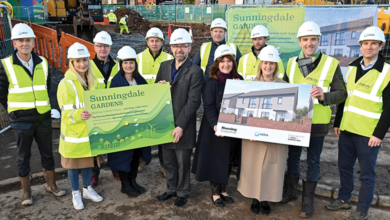Rebuilding Ireland: lessons and observations

Chief Executive Officer of the Housing Agency, John O’Connor, outlines Ireland’s approach to tackling its housing crisis and discusses lessons learned that could be built into future action plans for Northern Ireland.
In 2016, the Irish Government delivered an action plan to accelerate housing supply as a means to tackle the country’s housing shortage. Rebuilding Ireland, which received broad political support, was borne out of a cross-government committee which identified the key areas to be addressed.
O’Connor, whose agency supports local authorities, housing associations, the Department and the private sector in relation to delivery of housing and housing services, outlines the five key pillars of Rebuilding Ireland, which include:
- addressing homelessness;
- accelerating social housing supply;
- building more homes;
- improving the rental sector; and
- utilising empty homes.
Homelessness, he highlights, continues to be a major issue in Ireland since 2012, despite increased efforts towards prevention. In February 2019, there were over 6,480 adults recorded as homeless, of which 1,707 were families with 3,784 children.
Offering a word of advice for Northern Ireland’s housing sector, he adds: “The trends showing significant increases in family homelessness were evident from data and research in 2014 and the trend continued. It’s very important to keep an eye to data, statistics and trends and to act on warning signs at an early stage.”
Outlining some of the homelessness prevention initiatives currently being utilised, O’Connor highlights a particular focus on the issue of mortgage arrears, which affects over 60,000 households in Ireland. Some of the initiatives have focussed on mortgage restructuring and where this is not possible, utilisation of the Mortgage to Rent scheme, a government initiative that sees housing associations purchasing homes and facilitating the homeowner to continue living there as a social housing tenant.
On the ambition of accelerating social housing supply, he highlights that the Housing Agency actively sources houses and apartments, from bank portfolios, for use as social housing by housing associations and local authorities. To do this the agency has a ⇔70 million rotating fund to buy houses and apartments from lenders or the market and sells them on to housing associations. The Housing Agency also buys houses and apartments in trust for local authorities.
Turning to the ambition of building more homes, O’Connor outlines that Ireland needs to be supplying 30,000 plus homes per year across the public and private sector to meet demand estimates. Two key initiatives by government have focussed on land and on planning. Launched in 2018, the Land Development Agency was set up to to manage the State’s own lands to develop new homes and regenerate under-utilised sites, with the long-term ambition to assemble strategic land banks from public and private lands while stabilising land values and deliver increased affordability. The Government have also rolled out the Local Infrastructure Housing Activation Fund (LIHAF), providing funding aimed at enabling infrastructure on key sites to open up lands for early development.
Probably the biggest issue that we face is that we are still not building the right types of homes for the current and future demand.
O’Connor says: “In relation to public land, it’s important to identify how it is used. The Government have set parameters in relation to the sale of public land, outlining that 10 per cent must be used for social housing and 30 per cent for affordable housing. It means that even if a public sector body wants to sell land, they are now constrained by having to ensure terms of a social outcome for that land.”
Planning has also been playing an important role. As well as new standards published in 2018 around urban development for local authorities and new apartments for planning authorities, O’Connor highlights strategic housing developments introduced in 2017 which allow for housing development applications over a threshold of 100 homes or 200 student bed spaces to be submitted directly to the Planning Appeals Board, rather than through the traditional local authority route. A mandatory deadline of 16 weeks for all decisions has been set.
A further initiative in this area is the introduction of the higher vacant site levy, up to 7 per cent from 3 per cent from 2019 onwards.
O’Connor sates: “Probably the biggest issue that we face is that we are still not building the right types of homes for the current and future demand. We are still building three and four bedroom houses despite 55 per cent of households in the south consisting of just one or two people. This isn’t sustainable.”
The Chief Executive outlines his belief that too much of government policy has focussed on home ownership, to the detriment of the rental sector, pointing to the existing schemes such as the Help to Buy scheme and the Rebuilding Ireland Home Loan.
Under the action plan’s fourth pillar, improving the rental sector, he highlights a focus on trying to control private rents through the initial introduction and recent extension of rent pressure zones, restricting annual rent rises to 4 per cent or less and improving security of tenure for tenants.
He adds: “One major initiative that we are looking at and have started doing in a small way is providing a cost rental sector, which has been successful in many countries around Europe.” Cost rental housing involves a combination of state lands, infrastructure and long-term financing to reduce the costs of providing housing and therefore rents over a long-term.
Acknowledging that social housing rents in Northern Ireland are cost-based rents, he emphasises that the building of a cost rental sector would incorporate a “much broader cohort of households and much broader incomes”.
The final pillar O’Connor discusses is that of utilising empty homes. “Our 31 local authorities now all have Vacant Homes Officers with a major focus on getting empty homes back into use. There are various initiatives to assist this including property acquisitions from lender portfolios, the Repair and Leasing Scheme and the Buy and Renew Scheme.”
Northern Ireland
Offering some advice to stakeholders in the Northern Ireland housing sector, from experiences in Ireland, O’Connor says: “A strong suggestion I would make around home ownership is to have just one scheme. It would be a mistake for housing associations to develop their own shared housing schemes individually as this could be disruptive. However, there must also be a focus on affordability in the rental sector. There should be an ambition to provide rental accommodation that is affordable across a bigger cohort, not just a focus on home ownership alone.”
On development of public sector land he suggests long-term leases, with guaranteed long-term advantages, rather than sale. He adds: “Another recommendation is to look at capital investment rather than grants. In Ireland there has been a focus on grants and the Government takes current expenditure into consideration. However, there is a greater role for capital investment in housing to be utilised.”
Concluding, O’Connor says: “If there is one mistake we in Ireland have made that can be used as a reference for others, it’s that we have a large variety of initiatives. The lesson for the north is select a small number of initiatives and to stick with them.”





